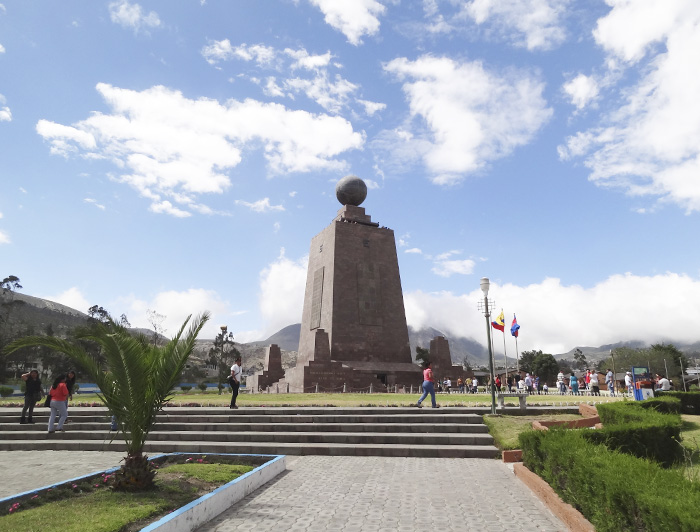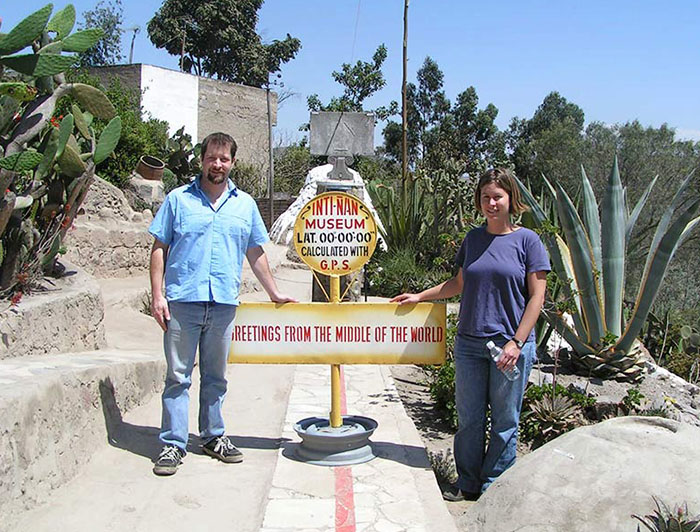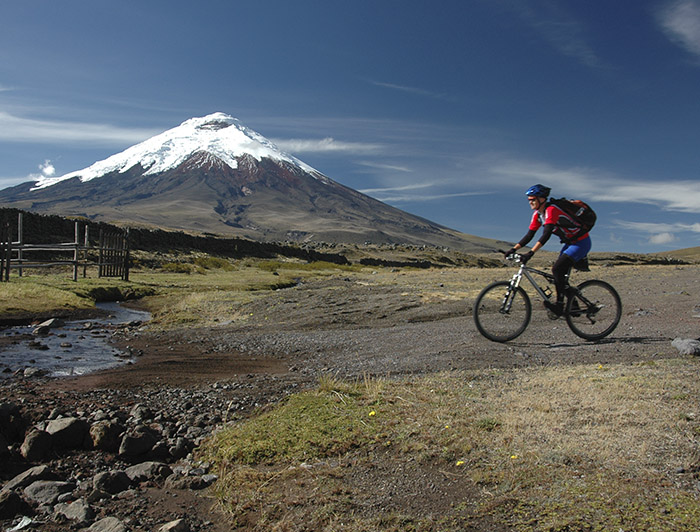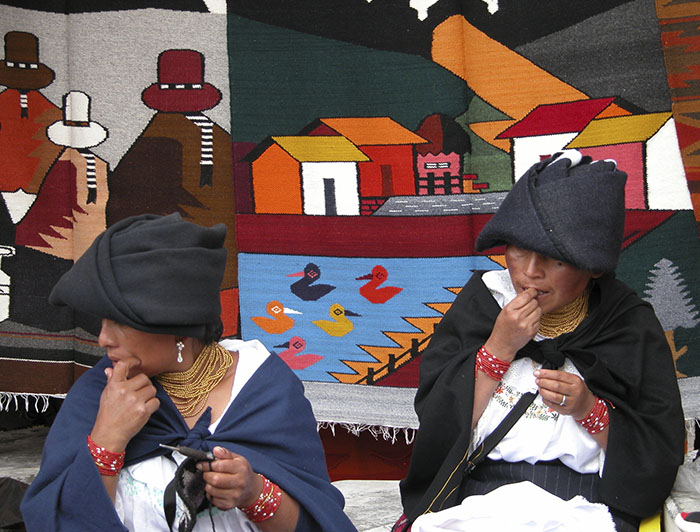
Five reasons why Quito should be your next travel destination | Travel Blog
The enthralling city of Quito is situated 2,800 meters above the sea level, making it the most elevated official capital city on earth. This is the perfect scenery to find traditions, nature and history in one place. The best example is the Quito’s historic center that is among the largest, best preserved, and least altered in the Americas and beyond.
The city (along with Krakow) was also the 1st World Cultural Heritage Site as declared in 1978 by UNESCO. Quito is clearly a must-visit this year. To top it all off, here are five more reasons you’ll never want to leave the city if you pay it a visit.
1. The Middle of the World
 The Middle of the World (or the La Mitad del Mundo) is perhaps the nation’s biggest claim of fame, given it attracts hundreds of thousands of visitors every year. This is the location where Charles Marie de La Condamine, Pierre Bouguer, and Louis Godin first determined the equatorial line back in the eighteenth century.
The Middle of the World (or the La Mitad del Mundo) is perhaps the nation’s biggest claim of fame, given it attracts hundreds of thousands of visitors every year. This is the location where Charles Marie de La Condamine, Pierre Bouguer, and Louis Godin first determined the equatorial line back in the eighteenth century.
Unluckily, their magnetic measurements were a bit wrong. Years later, GPS measurements showed that the real Equator line is located approximately 250 meters away from the shrine. Today, if you visit the location, you will find a signpost labeled “Ecuador; Latitud: 0° – 0’ 0’ “as calculated with GPS.
 Regardless of this slight flaw, The Middle of the World remains a rather famous tourist travel destination. If you love or are interested in international lifestyles and the culture of Ecuador’s native people, I am confident you’ll love Ciudad Mitad del Mundo.
Regardless of this slight flaw, The Middle of the World remains a rather famous tourist travel destination. If you love or are interested in international lifestyles and the culture of Ecuador’s native people, I am confident you’ll love Ciudad Mitad del Mundo.
The Museo Etnografico (also situated in close proximity) features lots of ordinary items that represent indigenous customs, rites, and traditions. The museum pays attention to all three continental regions of the nation. From the observation deck, you will have a clear view of the Andes and its surrounding mountains, like Cayambe. However, most travelers who visit Mitad Del Mundo are more fascinated by The Middle of the Earth. They get to partake in distinct demonstrations and experiments that show the effects of the equator. The most famous is trying to balance an egg on a nail.

2. Explore Quito’s Heritage City Center
Bearing in mind Quito boasts the best preserved and unaltered city center in all of Latin America, it is a must visit if you get to the nation. In case you are short on time, the best way to sightsee a vast majority of the Heritage city center is walking.
These free trips will show you the most significant Ecuadorian landmarks while explaining the historical implication necessary in order to comprehend present-day Quito. But do not stop there. There are lots of gorgeous streets and buildings to discover just a few steps away from the city center.
Particularly, there are two streets that are well worth your time; La Ronda Street, and San Marcos neighborhood.
La Ronda
Walk around La Ronda to get a glimpse into the Spanish era and Cultural heritage of the city. This energetic pedestrian street is a location where you can sample traditional foods, enjoy live entertainment, explore historic buildings, and watch artisans at work.
History dictates that La Ronda’s past extends back to the late 1300s. The Spanish colonists decided to remodel the street in the eighteenth century and by mid-1900s, it was a favorite hangout among musicians, poets, and artists. The street was also renamed to Calle Juan De Morales, but most locals still commonly refer to it as La Ronda.
Check out the flamboyant Spanish built homes as you stroll down the street. Explore the wrought – iron balconies decorated using vibrant floras, and even feel free to peek inside through the doors to appreciate beautiful patio courtyards.
San Marcos
Compared to La Ronda, this neighborhood is the better place to visit if you would like to experience the artistic and family ambiance. Originally stretching from Santa Catalina, Calle Montufar to the church and its court, the neighborhood combines Quito’s idiosyncrasy, sense of community, rich history, and artistic expression.
Erected during the 15th century, buildings here are mainly neoclassical or Republican style. The extended street is lined with pastel-painted constructions decorated with geraniums and neat shutters as well as flags hanging from the balconies.
Here, you’ll also find neighborhood workshops that have been run by the same families for hundreds of years and distinct age groups selling traditional street cuisines, such as maize pancakes.
At San Marcos, you can happily pass a day exploring the cafes, restaurants, or just enjoy a walk while you appreciate this quaint neighborhood.
Check out this tour, and visit Quito during your trip to Ecuador.
3. Discover, and let Cotopaxi Volcano leave awe on your face
 Your trip to Ecuador is incomplete if you do not visit the Cotopaxi National Park. Situated just a short distance from Quito, it is the perfect day trip.
Your trip to Ecuador is incomplete if you do not visit the Cotopaxi National Park. Situated just a short distance from Quito, it is the perfect day trip.
Cotopaxi is geological, photographic, and generally a sentimental sign in the hearts of most, if not all Ecuadorian locals.
 Travelers from around the world fall victim to the volcano’s beauty as they admire and fall in love with its enchanting features. While flying into the capital city during the day, you may see the beauty’s magnificent shape through your airplane window.
Travelers from around the world fall victim to the volcano’s beauty as they admire and fall in love with its enchanting features. While flying into the capital city during the day, you may see the beauty’s magnificent shape through your airplane window.
Note: that does not mean you can see Cotopaxi from all points in Quito or the central highlands.
Like a guardian angel that watches over a city and its neighboring metropolises, Cotopaxi is one of the daily sceneries Ecuador’s locals are used to.
4. Short magic trips from Quito
 Quito packs a lot of punch. The city is fortunate to be so close to some of the best tourist attractions Ecuador has to offer, such as Mindo, Papallacta, Otavalo, and the Middle of the World, just to mention but a few.
Quito packs a lot of punch. The city is fortunate to be so close to some of the best tourist attractions Ecuador has to offer, such as Mindo, Papallacta, Otavalo, and the Middle of the World, just to mention but a few.
 The Otavalo Market is a renowned local, you can see here the crafts & goods market and the animals market. Over the weekend, the animal market sells animals such as puppies or livestock at 5h00 in the morning. On Saturday you can visit the crafts & goods market, it enlarges from the main square of Otavalo into the neighboring side streets. Here, the people from Otavalo sell everything from spices for cooking to jewelry to blankets and indigenous musical instruments.
The Otavalo Market is a renowned local, you can see here the crafts & goods market and the animals market. Over the weekend, the animal market sells animals such as puppies or livestock at 5h00 in the morning. On Saturday you can visit the crafts & goods market, it enlarges from the main square of Otavalo into the neighboring side streets. Here, the people from Otavalo sell everything from spices for cooking to jewelry to blankets and indigenous musical instruments.- You should also most definitely get adventurous in the Mindo Cloud Forest. This attraction is just two hours from Quito and offers a wide array of outdoor adventures from tubing to hiking to biking and zip lining. You’ll also be treated to a perfect nursery for butterflies and orchids.
5. Enjoy the best Ecuadorian train rides through the Andes
When most individuals think about exploring Ecuador, train travel is usually not what first jumps into their minds. Nevertheless, there are some fascinating train tours in Ecuador that you should not miss if you ever visit the nation.
 Multiple rail lines here were constructed amidst the nineteenth century in order to link the Coast with Quito for commercial purposes. Until recent years, most of the lines were in somewhat of disarray having been destroyed by some landslides throughout the 1900s.
Multiple rail lines here were constructed amidst the nineteenth century in order to link the Coast with Quito for commercial purposes. Until recent years, most of the lines were in somewhat of disarray having been destroyed by some landslides throughout the 1900s.
The good news is, Ecuador has worked really hard to ensure it restores its grand train tracks, with some exciting extra options that you can choose from. Better yet, surrounded by diverse ecosystems and attractive landscapes, Ecuador’s Andes Highlands present the finest ecological setting for a train ride using the newly renovated rail lines.
Ecuador is the home of lakes, legends, and craftsmen where a train’s journey is filled with fascination and exotic views. These hard to beat train tours and rides permit you to enjoy Ecuador’s history, culture, and nature.
One of the most popular routes is the Devil’s Nose. Located in the central Andean region, it travels between Alausí and Sibambe. The marvelous engineering creativity that went into this machinery is truly remarkable, bearing in mind it was assembled more than a hundred years ago.
Take a look of these tour programs:
1. Galapagos Itinerary: Enchanted Luxury East and West Galapagos Islands Cruise
2. Galapagos Tour: Stunning Galapagos Tour
3. The Andes Cotopaxi Ride and Climb
4. Peru Tour: Family Adventure Tour
5. Ecuador Tour: Otavalo Market
Check Our Suggested Tours:
